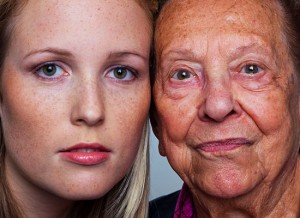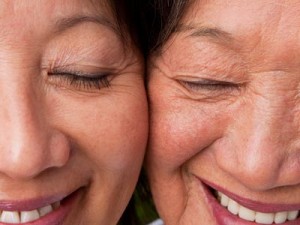 If you could take a class on how our skin ages, what do you think you would learn? Well, you are about to “attend Aging 101”. Here’s our syllabus:
If you could take a class on how our skin ages, what do you think you would learn? Well, you are about to “attend Aging 101”. Here’s our syllabus:
- We’ll look at the skin and what it is comprised of.
- We’ll examine the causes of aging.
- We’ll uncover some secrets to keeping your skin young.
Let’s get started!
The skin has many layers with components within each layer that work to keep the skin, the largest organ of your body, doing it’s job of protecting everything else inside the body. A cross section diagram of the skin shows those layers and what they look like when you are younger and then when you are older. The epidermis and subcutaneous fat layer is much thicker when you are younger, giving the look of smoother, more hydrated skin.
In 1962, two cell biologists, Dr. Leonard Hayflick and Dr. Paul Moorhead, made one of the greatest contributions to the history of cellular biology known as the Hayflick Theory. Hayflick theorized that the aging process was controlled by, what you might call, a biological clock contained within each living cell and that these cells have a limited life span, dividing approximately 50 times over a period of years and then stop. Essentially, anything that causes a cell to divide is what will eventually cause the death of a cell, when it will not divide any longer.
So what causes cell death or aging? Christine Heathman C.M.E., L.M.T., a licensed master aesthetician, has a lot say about the subject.
1. The most destructive cause of aging and the most destructive to DNA is solar UV radiation. According to Heathman, “The sun’s proton energy attacks the cell’s nucleus, scrambling DNA and setting off a sequence of events that speed up the cell’s aging process. Acute sun exposure provokes short- and long-term effects on the skin by damaging cells.”
2. Another, much more scientific, cause of aging is glucose driven intrinsic aging. Glucose is a vital cellular fuel and if it is significantly changed we call it glycation.
Heathman says, “The same browning reaction that occurs when you cook meat at a high heat takes place at a slower rate to long-lived tissue proteins such as collagen. Similarly in the human body, once sugars enter the circulation, they attach themselves to the amino groups of tissue proteins such as collagen to slowly rearrange the youthful structure into the main culprits of damage called advanced glycation end products (AGEs).” Now, that’s an easy way to remember it AGEs just as in we age. She goes on to say, “Glycation directly increases the release of matrix metalloproteinase (MMP-1) which breaks down collagen and although this action takes place internally, external sources of oxidative stress cause a double dose of danger, leading to accelerated aging.”
 3. Lastly, Heathman explains, “The free radical theory of cellular aging has long been established as an integral part of aging . . . Free radical is a term used to describe any molecule differentiated from conventional molecules that possess a free electron – a property that makes it react with other molecules in highly volatile and destructive ways. Free radicals attack the structure of cell membranes, thereby creating waste products, including substances known as lipofuscins that in turn interfere with the cell’s ability to repair and reproduce themselves. ” Our environment plays a huge part in creating free radicals as well as what we eat and drink. Essentially anything you ingest that is not a natural substance which the body can recognize and break down, or chemicals you might use in the garden or second hand smoke, for example, can be considered highly toxic to your skin and create that disturbance in your body’s ability to cleanse and repair the cells in your skin.
3. Lastly, Heathman explains, “The free radical theory of cellular aging has long been established as an integral part of aging . . . Free radical is a term used to describe any molecule differentiated from conventional molecules that possess a free electron – a property that makes it react with other molecules in highly volatile and destructive ways. Free radicals attack the structure of cell membranes, thereby creating waste products, including substances known as lipofuscins that in turn interfere with the cell’s ability to repair and reproduce themselves. ” Our environment plays a huge part in creating free radicals as well as what we eat and drink. Essentially anything you ingest that is not a natural substance which the body can recognize and break down, or chemicals you might use in the garden or second hand smoke, for example, can be considered highly toxic to your skin and create that disturbance in your body’s ability to cleanse and repair the cells in your skin.
So how do we keep our skin younger?
Heathman says, “A word of advice, I always tell my clients, ‘Your skin will be older tomorrow than it is today. It is my job to prevent that from happening.’ Yes, we cannot stop chronological intrinsic aging as set by our biological clock, but it is possible to manage extrinsic aging and reset the skin’s aging clock, realistically turning it back by 10 or 15 clinical years, with proper skin care formulations and treatments. I know because I am living proof of it.”
What is your skin regimen? Do you give back to your skin with a professional facial every now and then? What kind of products do you use on a daily basis?



Recent Comments